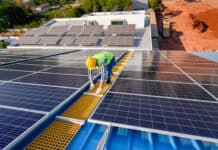 In Europe, almost 40% of the total energy generated is used in buildings. Solar thermal energy, that is, the conversion of solar energy into heat, will play a key role in future in meeting the energy demand of buildings, as solar heating can be used here both for hot water production and space heating, as well as cooling.
In Europe, almost 40% of the total energy generated is used in buildings. Solar thermal energy, that is, the conversion of solar energy into heat, will play a key role in future in meeting the energy demand of buildings, as solar heating can be used here both for hot water production and space heating, as well as cooling.
Through EU political energy guidelines, as well as tougher environmental protection requirements, energy efficient and solar construction and renovation are increasingly gaining in importance. The share of renewable energies in Europe is due to rise to 20% by 2020. According to estimates from the European Solar Thermal Industry Federation (ESTIF), solar thermal energy will cover 12% of the target growth, or provide 3.6% of the total demand of the EU’s 27 member states for heating and cooling.
In line with new plans from the EU Commission, all new buildings should be built as “near-zero energy buildings” by December 31, 2020. The redevelopment of existing buildings to make them more energy efficient should be the aim of all member states, with public buildings playing an exemplary role.
In other words, by 2020, the majority of outdated heating systems in Europe must be replaced with new systems which optimally combine both energy efficiency and the use of renewable energy. Yet, the aims of the EU can only be reached if solar heat recovery takes on a significantly stronger role in future in the energy provision of buildings.
“We expect the solar thermal market to grow vastly in the future. Solar thermal energy has the potential to cover around 15% of the demand for low temperature heating in the EU by 2030, and as much as 47% by 2050,” says Xavier Noyon, CEO of ESTIF.
One condition of expansion is, however, that the widespread reluctance to invest be overcome and that solar thermal energy receive investment now. In addition, it is essential to develop technologies for the adoption of solar thermal energy. Researchers and manufacturers see significant potential for development, particularly in the solar heating of buildings, the generation of process heat for industrial use, and in solar cooling. Moreover, the cost of installations should in future be significantly reduced.
Better integration into the building envelope and the development of new technologies for solar collectors provide the focus for the industry. Collector types, such as air heaters, which to date have had only minor significance but which have very encouraging prospects should undergo significant development. Even process heat collectors, which can heat water up to 250°C, are being intensively researched and further developed for the market.
So far, it is possible to meet around 20% to 30% of a building’s heating requirements with solar thermal installations for auxiliary heating at a relatively low cost. A significantly higher proportion of solar provision can therefore be attained when more efficient heat storage tanks are available.
Developers in the technologically leading research institutes and companies within the industry are therefore pursuing the aim of developing a new generation of highly efficient heat storage tanks. By using effective and efficient solar thermal installations, it will be possible to meet the heating and cooling demands of “active solar buildings” entirely through solar energy.

















![[VIDEO] Collect Asset Data at the Speed of Walking a Building](https://facilityexecutive.com/wp-content/uploads/2024/02/maxresdefault-324x160.jpg)